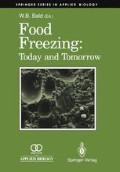Abstract
Foods are characterised by their heterogeneous nature, typically they contain many components, more than one phase and spatial heterogeneity on a variety of scales. A further complication is that almost all foods are unstable chemically and physically and are thus highly time dependent in their properties. A good example is a loaf of bread (Fig. 1.1); the major components are wheat flour and water; minor components are sodium chloride, air, sugar, and possibly alcohol from fermentation; there will also be yeast cells in various states of decomposition and damage. The yeast is a highly complex and organised system, it is not however a major component. The chemically most complex major component is flour. This contains gluten and other proteins, starch, lipids and other polysaccharides, each one of these components is itself chemically heterogeneous. The air, although a small component by weight, plays a major role in determining the size and shape of the loaf and is responsible for the foam structure of the crumb.
Access this chapter
Tax calculation will be finalised at checkout
Purchases are for personal use only
Preview
Unable to display preview. Download preview PDF.
References
Angell CA (1982) Supercooled water. In:Franks F (ed) Water a comprehensive treatise Vol 7. Plenum New York, pp 38
Belton PS (1984) Spectroscopic methods. In:Chan HW-S (ed) Biophysical methods in food research. Blackwell, Oxford, pp 103–137
Belton PS (1990) Can NMR give useful information about the state of water in foodstuffs? Comments on Food and Agricultural Chemistry (in press)
Belton PS, Duce SL and Tatham AS (1988) Proton NMR relaxation studies of dry gluten. J Cereal Sci 7:113–22
Berendsen HJC (1981) Specific interactions of water with biopolymers. In: Franks F (ed) Water a comprehensive treatise, vol 5. Plenum, New York and London, pp 293–330
Derbyshire W (1982) The dynamics of water in heterogeneous systems with emphasis on sub-zero temperatures. In:Franks F (ed) Water a comprehensive treatise, vol 7. Plenum, New York, pp 339–430
Franks F (1982) The properties of aqueous solutions at sub-zero temperatures. In: Franks F (ed) Water a comprehensive treatise, vol 7. Plenum, New York, pp 261–270
Franks F (1986) Unfrozen watenyes; unfreezable water:hardly; bound water:certainly not. CryoLetters 7:207
Glasstone S (1960) Textbook of physical chemistry. Macmillan, London, pp 498
Hunter RJ (1987) Foundations of colloid science. OUP, Oxford, pp 272–277
Johari GP (1982) Glass transition and molecular mobility. In.Escaig B and G’Sell C (eds) Plastic deformation of amorphous and semi-crystalline materials. Les Editions de Physique, Les Ulis, France, pp 110–141
Kakalis L and Baianu I (1988) Oxygen 17 and deuterium NMR relaxation studies of lysozyme hydration in solution. Arch Biochem Biophys 267:829–841
Kapsalis JG (1987) Influences of hysteresis and temperature on moisture sorption isotherms. In: Rockland LB and Beuchat LR (eds) Water activity theory and applications to food. Marcel Bekker, New York, pp 173–213
Kuntz ID and Kauzmann W (1974) Hydration of proteins and polypeptides. Adv Protein Chem, 28:239–345
Lechert HT (1981) Water binding in starch:NMR studies on native and gelatinized starch. In:Rockland LB and Stewart GF (eds) Water activity:influences on food quality. Academic, New York, pp 223–245
Levine H and Slade L (1989) Interpreting the behaviour of low-moisture foods. In: Hardman TM (ed) Water and food quality. Elsevier, London, pp 71–134
MacKenzie AP (1975) The physico-chemical environment during the freezing and thawing of biological materials. In: Duckworth RB (ed) Water relations of foods. Academic, London, pp 477–503
Nagashima N and Suzuki E-I (1984) Studies of hydration by broad line pulsed NMR. Appl Spectrosc Rev 20:1–53
Tanner SF, Ring SG, Whittam MA and Belton PS (1987) High resolution solid state 13C NMR of some 1–4 glucans. Int J Biol Macromol 9:219–224
van den Berg C and Brain S (1981) Water activity and its estimation in food systems:theoretical aspects. In: Rockland LB and Stewart GF (eds) Water activity:influences on food quality. Academic, New York, pp 1–61
Wilkie DR (1970) Muscle. Edward Arnold, London, pp 3–7
Editor information
Editors and Affiliations
Rights and permissions
Copyright information
© 1991 Springer-Verlag London Limited
About this chapter
Cite this chapter
Belton, P.S. (1991). The Physical State of Water in Foods. In: Bald, W.B. (eds) Food Freezing. Springer Series in Applied Biology. Springer, London. https://doi.org/10.1007/978-1-4471-3446-6_1
Download citation
DOI: https://doi.org/10.1007/978-1-4471-3446-6_1
Publisher Name: Springer, London
Print ISBN: 978-1-4471-3448-0
Online ISBN: 978-1-4471-3446-6
eBook Packages: Springer Book Archive

